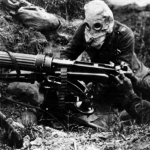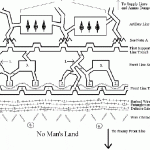World War One shattered the empires of Russia, the Ottomans, and the Austro-Hungarians, which had all existed in one form or another for centuries. That’s because it broke the fragile alliances that kept these Empires alive. In this episode, we explore the Southern Fronts of World War One in 1916-1917. Starting with Italy, since Italy’s entry into the war, Italy and Austria had fought several battles along their border in the Alps. Neither side was able to make headway until May 1916, when Austria launched the “Punishment Expedition,” which pushed the Italian army back. In the winter of 1915-16, the Serbian army, with many civilians along fled Serbia into the mountains of Albania toward the coast. 200,000 died along the way. By mid-January 1916, the Allies were taking thousands from the Albanian coast to the Greek island of Corfu. Also in January, Austria-Hungary invaded Montenegro. Within 2 weeks, the government surrendered, although the army retreated into Albania. The Austrians followed them there, occupying Albania. Things were no better in the Ottoman Empire. It was due to divisions between its Turkish-speaking populations and Arabic-speaking populations. The same centrifugal forces that pulled apart the Austro-Hungarian empire were affecting the Ottoman Empire.
- Italy / Austria
- Since Italy’s entry into the war, Italy and Austria had fought several battles along their border in the Alps. Neither side was able to make headway until May 1916, when Austria launched the “Punishment Expedition,” which pushed the Italian army back.
- In August, the Italian army counterattacked and captured Gorizia, which the Austrians had previously occupied. But further attempts to advance were halted.
- Throughout the summer and fall of 1916, Austria and Italy continued to fight around the Isonzo River.
- Things were mostly quiet in the fall and winter of 1916-17, but on May 12 the Italians launched an attack (10th Battle of the Isonzo). The Italians took Zagorra and Mount Santo, although they lost the latter very quickly. The battle ended in early June. It was technically an Italian victory, but they lost twice as many men as the Austrians did.
- On August 18, the Italians began the 11th Battle of the Isonzo, attacking along the entire front. This was the deadliest of the Isonzo battles. It ended on Sept. 12.
- On October 24, the Austrians and Germans launched the Twelfth Battle of the Isonzo (aka Battle of Caporetto). Within two days, the Italians had lost 60,000 prisoners and were in flight. The Central Powers forces gained about 60 miles of territory, but the Italians regrouped at the Piave River.
- When the battle ended nine days later, the Italians had lost 10,000 killed and 280,000 prisoners. Despite this, the Italians’ morale increased, since they were now fighting for their homeland, not conquest.
- Italian commander Cadorno was fired and replaced with General Armando Diaz.
- The Balkans
- In the winter of 1915-16, the Serbian army, with many civilians along fled Serbia into the mountains of Albania toward the coast. 200,000 died along the way. By mid January 1916, the Allies were taking thousands from the Albanian coast to the Greek island of Corfu.
- Also in January, Austria-Hungary invaded Montenegro. Within 2 weeks, the government surrendered, although the army retreated into Albania. The Austrians followed them there, occupying Albania.
- The British and French forces that had tried to help the Serbs and been forced back established a major military base at Salonika (over the objections of many Greeks, whose neutrality was being violated).
- In Salonika, the British and French formed a five-nation army (French, British, Italian, Serbian, and Greek) of nearly 750,000 men. They prepared to attack Bulgarian forces to the north. In the summer, they slowly began advancing northward.
- In November, the five nation army took Monastir (in southern Serbia).
- Meanwhile, Greece had divided into Royalists and Venezelists (supporters of the prime minister). When a group of allied troops was attacked in Athens, the Allies blockaded Greece and occupied the Cyclides.
- In late February 1917, the Toplice Rebellion, by Serbs in Bulgarian-controlled territory in the Balkans, began. It was put down on March 25, although some guerrilla resistance continued.
- In March, the French and British forces in Greece advanced northward. The next month, the Allies attacked Bulgarian forces in Macedonia. The Bulgarians, aided by German naval guns and infantry, fought off the British.
- Another Allied attack in early May failed.
- In June, King Constantine of Greece abdicated in favor of his son Alexander. On the 28th, Greece officially joined the Allies.
- On July 20, representatives of the Serbs, Croats, and Slovenes issued the Pact of Corfu, calling for a South Slavic confederation under the leadership of the Serbian royal family.
- Romania
- In August 1916, Romania joined the war on the side of the Allies. Soon afterward, a joint Bulgarian-Turkish force commanded by German general August von Mackensen invaded southern Romania.
- At the same time, German and Austrian forces under the command of Erich von Falkenhayn invaded from the west.
- Russia tried to send help, but it took a long time for their forces to arrive.
- In December, the Central Powers forces captured Bucharest. The defenders had destroyed as much grain and oil as possible, but much still fell into the attackers’ hands.
- The fighting mostly ceased until the summer of 1917. The Romanians recruited new soldiers, including some who had formerly fought in the Austrian army.
- In early August, the Russian/Romanian forces pushed back the Central Powers a bit. But the Central Powers fought back and soon defeated the Russians.
- On December 5, Romania ceased hostilities.
- Middle East
- In mid-February, a Russian force that had crossed the Caucasus took the port city of Erzurum. Soon afterward, they took Trabzon and began to advance on Bitlis, the gateway to Mesopotamia.
- In the winter and spring of 1916, the British sent several expeditions to relieve their trapped force in Kut al-Amara, but all failed to reach them.
- Facing starvation the British garrison at Kut surrendered on April 29. The 12,000 British and Indian garrison force was marched off to Baghdad and then to prison camps in Anatolia, in what turned into a death march. 70% of the British and about 30% of the Indian soldiers died.
- In May 1916, the Sykes-Picot treaty was signed (with Russian approval). The treaty divided the Ottoman holdings in the Middle East into zones of influence. It took no notice of cultural, religious or ethnic boundaries.
- In June (encouraged by the British), Hussein bin Ali (Sharif and Emir of Mecca) and his sons proclaimed a revolt against the Ottomans. Arab forces, aided and financed by the British, began capturing cities. By mid-July, they had captured Jeddah and Mecca. Soon after, they took Yanbo, the port of Medina.
- In December, a new British force marched north up the Tigris toward Kut.
- Another force captured El Arish (in Palestine) on December 22.
- On March 11, 1917, Allied forces recaptured Kut Al-Amara and then took Baghdad.
- On the 26th, British forces in Egypt marched on Gaza, but they were turned back by Turkish forces guarding it. A second attack in April also failed.
- On April 21, the British captured Istabulat. This ended any Ottoman hopes for regaining a strategic stronghold in the region.
- On July 2, Arab forces led by T. E. Lawrence captured Aqaba. This provided a base relatively close to Suez and Syria.
- In late September, British forces defeated the Ottomans on the Euphrates River near Ramadiya (north of Baghdad).
- On October 3, T. E. Lawrence and his forces blew up part of the Hejaz Railway.
- On October 31, General Edwin Allenby led an attack on Beersheba. A cavalry charge was a key part of the attack. A week later, Gaza fell to Allied forces. Further towns fell soon.
- On December 7, Jerusalem surrendered to the Allies. The British commander General Allenby read a proclamation guaranteeing the sanctity of the city.
Cite This Article
"Italy in World War One" History on the Net© 2000-2024, Salem Media.
July 27, 2024 <https://www.historyonthenet.com/italy-in-world-war-one>
More Citation Information.








